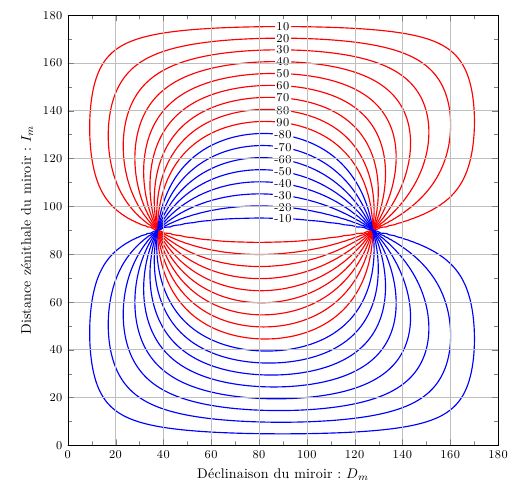用pgfplots宏包绘制等高线并标注
http://tex.stackexchange.com/questions/62504/label-curve-and-or-contour-name-created-with-pgfplot-via-gnuplot?rq=1
\documentclass[a4paper]{article}
\usepackage[T1]{fontenc}
\usepackage[utf8,applemac]{inputenc}
\usepackage{lmodern, textcomp}
\usepackage{mathrsfs,bm}
\usepackage{amsmath,amssymb,amscd}
\usepackage{comment,relsize}
\usepackage[frenchb]{babel}
% ==============================================
\usepackage[babel=true,kerning=true]{microtype}%pour le package tikZ et les deux points``:''
%%% TikZ packages.
\usepackage{pgfplots}
\usetikzlibrary{intersections}
%
\pagestyle{empty}
\pgfplotsset{compat=newest}
% ==============================================
\begin{document}
% ==============================================
\pgfkeys{
/pgfplots/linelabel/.style args={#1:#2}{
name path global=labelpath,
execute at end plot={
\path [name path global = labelpositionline]
(rel axis cs:#1,0) -- (rel axis cs:#1,1);
\path [name intersections={of=labelpath and labelpositionline, total=\total}]
(intersection-\total) node [fill=white,inner xsep=1pt, inner ysep=0pt, font=\small] {#2};
}
}
}
\begin{tikzpicture}
% réglage de la grille de coordonnées
\begin{axis}
[ grid=major,
no markers,
axis on top,
tick label style={font=\small},
%extra y tick style={grid=major},
%extra x tick style={grid=major}
minor y tick num=1,
minor x tick num=1,
%smooth,
xlabel={D{\'e}clinaison du miroir: $D_m$},
ylabel={Distance z{\'e}nithale du miroir: $I_m$},
xmin=0, xmax=180,
ymin=-0, ymax=180,
width=1\textwidth,
height=1\textwidth,
legend style={at={(0.02,0.97)},anchor=north west},
legend pos=south east,
legend cell align=left
]%
% Création des graphes f(x,y)=0 via GNUPLOT
\pgfplotsinvokeforeach{10,20,...,90}{
\pgfmathsetmacro\labelpos{#1/200}
\addplot [ linelabel=0.5:#1,no markers, red, raw gnuplot, thick, empty line = jump ]%
gnuplot {%
set contour base;
set cntrparam levels discrete 0.0000;
unset surface;
set view map;
set grid;
set isosamples 200;
set xrange [0:180];
set yrange [0:180];
D=pi/180*165; %<<--------- ICI
I=pi/180*90; %<<--------- ICI
k=tan(pi/180*#1);
f(x,y)= k*(cos(D) + cos((D-2*pi/180*x)) * tan(pi/180*y)**2) - 2*sin(I) * sin(pi/180*x) * tan(pi/180*y)-cos(I) * (sin(D)+sin((D-2*pi/180*x)) * tan(pi/180*y)**2);
splot f(x,y);
};%
}
%
\pgfplotsinvokeforeach{-10,-20,...,-80}{
\addplot [ linelabel=0.5:#1, no markers, blue, raw gnuplot, thick, empty line = jump ]%
gnuplot {%
set contour base;
set cntrparam levels discrete 0.0000;
unset surface;
set view map;
set grid;
set isosamples 200;
set xrange [0:180];
set yrange [0:180];
D=pi/180*165; %<<--------- ICI
I=pi/180*90; %<<--------- ICI
k=tan(pi/180*#1);
f(x,y)= k*(cos(D) + cos((D-2*pi/180*x)) * tan(pi/180*y)**2) - 2*sin(I) * sin(pi/180*x) * tan(pi/180*y)-cos(I) * (sin(D)+sin((D-2*pi/180*x)) * tan(pi/180*y)**2);
splot f(x,y);
};%
}
\end{axis}
%
\end{tikzpicture}
% ==============================================
\end{document}

\documentclass[a4paper]{article}
\usepackage[T1]{fontenc}
\usepackage[utf8,applemac]{inputenc}
\usepackage{lmodern, textcomp}
\usepackage{mathrsfs,bm}
\usepackage{amsmath,amssymb,amscd}
\usepackage{comment,relsize}
\usepackage[frenchb]{babel}
% ==============================================
\usepackage[babel=true,kerning=true]{microtype}%pour le package tikZ et les deux points``:''
%%% TikZ packages.
\usepackage{pgf,tikz}
\usepackage{pgfplots}
%
\pagestyle{empty}
\pgfplotsset{compat=newest}
% ==============================================
\begin{document}
% ==============================================
\begin{tikzpicture}
% réglage de la grille de coordonnées
\begin{axis}
[ grid=major,
no markers,
axis on top,
tick label style={font=\small},
%extra y tick style={grid=major},
%extra x tick style={grid=major}
minor y tick num=1,
minor x tick num=1,
%smooth,
xlabel={D{\'e}clinaison du miroir: $D_m$},
ylabel={Distance z{\'e}nithale du miroir: $I_m$},
xmin=0, xmax=180,
ymin=-0, ymax=180,
width=1\textwidth,
height=1\textwidth,
legend style={at={(0.02,0.97)},anchor=north west},
legend pos=south east,
legend cell align=left
]%
% Création des graphes f(x,y)=0 via GNUPLOT
\pgfplotsinvokeforeach{10,20,...,90}{
\addplot [ contour prepared, point meta=#1, contour/label distance=10cm, contour/draw color=red, no markers, red, raw gnuplot, thick, empty line = jump ]%
gnuplot {%
set contour base;
set cntrparam levels discrete 0.0000;
unset surface;
set view map;
set grid;
set isosamples 200;
set xrange [0:180];
set yrange [0:180];
D=pi/180*165; %<<--------- ICI
I=pi/180*90; %<<--------- ICI
k=tan(pi/180*#1);
f(x,y)= k*(cos(D) + cos((D-2*pi/180*x)) * tan(pi/180*y)**2) - 2*sin(I) * sin(pi/180*x) * tan(pi/180*y)-cos(I) * (sin(D)+sin((D-2*pi/180*x)) * tan(pi/180*y)**2);
splot f(x,y);
};%
}
%
\pgfplotsinvokeforeach{-10,-20,...,-80}{
\addplot [ contour prepared, contour/label distance=10cm, contour/draw color=blue, point meta=#1, no markers, blue, raw gnuplot, thick, empty line = jump ]%
gnuplot {%
set contour base;
set cntrparam levels discrete 0.0000;
unset surface;
set view map;
set grid;
set isosamples 200;
set xrange [0:180];
set yrange [0:180];
D=pi/180*165; %<<--------- ICI
I=pi/180*90; %<<--------- ICI
k=tan(pi/180*#1);
f(x,y)= k*(cos(D) + cos((D-2*pi/180*x)) * tan(pi/180*y)**2) - 2*sin(I) * sin(pi/180*x) * tan(pi/180*y)-cos(I) * (sin(D)+sin((D-2*pi/180*x)) * tan(pi/180*y)**2);
splot f(x,y);
};%
}
\end{axis}
%
\end{tikzpicture}
% ==============================================
\end{document}
Code for second example